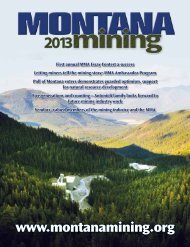2009 Montana Mining - Montana Mining Association
2009 Montana Mining - Montana Mining Association
2009 Montana Mining - Montana Mining Association
You also want an ePaper? Increase the reach of your titles
YUMPU automatically turns print PDFs into web optimized ePapers that Google loves.
STILLWATER MINING COMPANY:<br />
Committed to<br />
environmental sustainability<br />
Stillwater <strong>Mining</strong> Company’s (SMC) proactive environmental stance,<br />
and its commitment to socially responsible management of its<br />
operations, has lead to cutting edge innovation and operational partnering<br />
which continues to be a model for the mining industry.<br />
WATER TREATMENT AND OPERATIONAL INNOVATION<br />
East Boulder Mine Water Treatment<br />
The East Boulder Mine is located near the pristine waters of the<br />
Boulder River, 32 miles southwest of Big Timber. The mine operates in<br />
a glacier-carved mountain valley in the Beartooth Mountains, where<br />
the East Boulder River forms the boundary of the permit area on the<br />
east and north sides. Protection of the East Boulder River is the number<br />
one priority within the environmental stewardship program at the<br />
East Boulder Mine. For more than ten years, since mining began, the<br />
East Boulder Mine has had no measurable impact on the surface<br />
water quality within the East Boulder River.<br />
Water management and water treatment at the East Boulder Mine<br />
is defined by a tradition of innovation. In 2008, the East Boulder Mine<br />
continued this tradition with additional improvements to the water<br />
treatment systems. Systems already in place include the mine water<br />
recycle system (80 to 90 percent water recycle/re-use), biological denitrification<br />
(biological treatment of nitrate), biological nitrification<br />
(treatment of ammonia), land application, and snowmaking. The biological<br />
treatment systems are very efficient in nitrate and ammonia<br />
removal. However, during the winter months colder water temperatures<br />
tend to inhibit biological activity and result in a moderate loss of<br />
treatment efficiency. During 2008, the East Boulder Mine installed a<br />
heat exchanger/boiler system that maintains a minimum water temperature<br />
of 12 degrees Celsius (53.6°F) throughout the biological treatment<br />
cells. The resulting biological water treatment during the 08/09<br />
22 <strong>Montana</strong> <strong>Mining</strong> <strong>2009</strong><br />
Denitrification System at the East Boulder Mine.<br />
Aerial of Stillwater Mine.<br />
winter season (measured in percent nitrogen removed) has exceeded<br />
99 percent, and has set a new standard for winter time removal efficiencies<br />
at the mine site.<br />
Looking forward into <strong>2009</strong>, the East Boulder Mine is currently in the<br />
process of designing a reverse osmosis (RO) water treatment system<br />
that would function as a polishing cell or a backup system for the biological<br />
treatment systems. The RO system would have the flexibility to<br />
be used for mine water treatment or tailings water treatment in order<br />
to maintain the proper water balance, both in the underground mine<br />
and in the surface tailings storage facility. Improvements such as these<br />
further demonstrate Stillwater <strong>Mining</strong> Company’s commitment to the<br />
environment, and will help guarantee long-term protection of the surface<br />
water resources within the East Boulder valley.<br />
Stillwater Tertiary Treatment<br />
for Septic Waste Water<br />
The Stillwater Mine near Nye, <strong>Montana</strong> is located adjacent to the<br />
Stillwater River and is approximately two miles north of the Absaroka-<br />
Beartooth Wilderness Area. The Stillwater River flows through more<br />
than twenty miles of wilderness before spilling out into the rolling<br />
prairie and forested canyons along its 45 mile journey to the<br />
Yellowstone River near the town of Columbus.<br />
In order to protect surface water and groundwater resources within<br />
the Stillwater Valley, SMC made a decision to replace the existing septic<br />
and leach field system with a state-of-the-art AdvanTex Treatment<br />
System for wastewater treatment. The AdvanTex Treatment System is<br />
a multiple-pass, packed bed aerobic wastewater treatment technology<br />
specifically designed and engineered for long-term processing of<br />
wastewater. The treatment system utilizes textile media and naturallyoccurring<br />
microorganisms to biologically treat the wastewater. The



